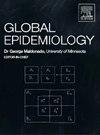Generalized anxiety disorder and associated factors among Sudanese adolescents during the Sudan Army conflict: A cross sectional study
引用次数: 0
Abstract
Background
Anxiety is the state of being worried and uneasy about anything that happens either now or in the future. It is unclear what exactly causes generalized anxiety disorder (GAD). According to some research, a variety of variables, including heredity, differences in brain chemistry, and environmental influences, could be involved. After the Sudanese army battle began in 2023, the purpose of this study was to determine the prevalence of generalized anxiety disorder among Sudanese teenagers.
Methods
A cross-sectional, community-based study was carried out among all Sudanese adolescents between 13 and 18 years old who were living in Sudan at the start of the conflict by using a self-administered questionnaire under the guidance of parents, if necessary. The questionnaire was adapted from the Generalized Anxiety Disorder-7 checklist for the assessment of GAD symptoms. The questionnaire was translated into Arabic by expert translators, and its validity and reliability were confirmed. Data were analyzed and presented in the form of descriptive and inferential statistics.
Results
Among the 855 participants, the mean age was 16.5 years, 66.8 % were female, and 50.8 % had generalized anxiety disorder. There was a significant positive relationship between GAD and age, sex, current residency, and traumatic events exposure. With participants aged 17–18 years old having 82 % higher odds of experiencing GAD in comparison with the reference age group (OR = 1.8 (95 % CI [1.2, 2.7])). Furthermore, females were found to have 92 % higher odds for GAD as compared with men (OR = 1.9 (95 % CI [1.4, 2.6])). Whereas internally displaced participants showed 205 % higher odds of GAD in comparison to those who had not been in a war zone (OR = 3.1 (95 % CI [2.11, 4.4])). In addition, experiencing a traumatic event during the war increases the odds of having GAD by 126 % in comparison to those who did not experience it (OR = 2.3 (95 % CI [1.7, 3.1])).
Conclusion
GAD was highly prevalent among the Sudanese adolescents included in the present study. The findings will help the government to provide proper mental health interventions for affected people.
苏丹军队冲突期间苏丹青少年的广泛性焦虑障碍及其相关因素:一项横断面研究
焦虑是对现在或未来发生的任何事情感到担心和不安的状态。目前还不清楚究竟是什么导致了广泛性焦虑症(GAD)。根据一些研究,包括遗传、脑化学差异和环境影响在内的各种变量都可能涉及其中。在苏丹军队于2023年开始战斗后,本研究的目的是确定苏丹青少年中广泛性焦虑症的患病率。方法对冲突开始时居住在苏丹的所有13至18岁的苏丹青少年进行了一项以社区为基础的横断面研究,在父母(如有必要)的指导下使用自填问卷。问卷改编自广泛性焦虑障碍-7检查表,用于评估广泛性焦虑症的症状。通过专家翻译将问卷翻译成阿拉伯文,验证问卷的效度和信度。数据以描述性和推理统计的形式进行分析和呈现。结果855名参与者的平均年龄为16.5岁,66.8%为女性,50.8%患有广泛性焦虑症。GAD与年龄、性别、当前居住地和创伤性事件暴露之间存在显著的正相关。与参考年龄组相比,17-18岁的参与者患广泛性焦虑症的几率高出82% (OR = 1.8 (95% CI[1.2, 2.7]))。此外,女性患广泛性焦虑症的几率比男性高92% (OR = 1.9 (95% CI[1.4, 2.6]))。然而,国内流离失所的参与者与没有在战区的参与者相比,GAD的几率高出205% (OR = 3.1 (95% CI[2.11, 4.4]))。此外,与没有经历创伤性事件的人相比,在战争期间经历创伤性事件的人患广泛性焦虑症的几率增加了126% (OR = 2.3 (95% CI[1.7, 3.1]))。结论ad在本研究的苏丹青少年中非常普遍。研究结果将有助于政府为受影响的人提供适当的心理健康干预。
本文章由计算机程序翻译,如有差异,请以英文原文为准。
求助全文
约1分钟内获得全文
求助全文

 求助内容:
求助内容: 应助结果提醒方式:
应助结果提醒方式:


